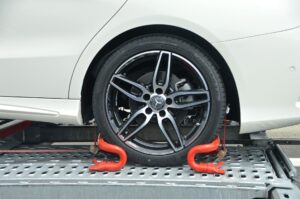Off-road driving is one of the best perks that comes with driving SUVs and trucks. Over the years we have seen even smaller sedans and hatchbacks with amazing off-road capabilities.
This all can be attributed to modern driving technology like the electronic locking differential and limited-slip axle. One question that you might probably be asking is which amongst the two is the best option when it comes to not only off-road driving but the overall driving experience.
Well to be able to answer that question, it is important to look at the differences between the electronic locking differential and limited-slip axle.
One of the main differences when it comes to the two is that the electronic locking differential locks both wheels of the axle electronically while the limited slip differential gives power to the wheel with higher resistance/traction than the wheel with least resistance/traction. but there is more and we are going to be getting into that a bit more in this article.
Contents
Electronic Locking Differential
The electronic locking axle is one of the most futuristic differential technologies available on the market right now.
The concept, which was embraced by companies like Ford and Jeep, is now available as an aftermarket accessory for your vehicle. This means that even if your car has an ABS or VSES (vehicle stability enhancement) system in place it will still work with the electronic locking axle.
If you are wondering why the concept has set the automotive world ablaze, wait until we get into the working principle of the electronic locking differential.
The locking differential concept has always been there and anyone who is into rock climbing or general off-road driving will tell you that being able to lock your differential will do your driving a lot of good.
Now imagine adding an electronic component to an already perfect system. Magical, right? Well according to our own experience, it is better than actual magic. Here is why.
Working Principle of Electronic Locking Differential
In terms of the working principle the electronic locking axle is like your normal locking differential there is only a twist on how it is activated and a bit of an improvement in terms of overall performance.
If you have previously had a chance to use a kicking differential in the past then you can testify on how much it improves traction and makes the during experience quite breathtaking. This is the same concept with the electronic locking axle.
With the electronic locking axle once the vehicle is in a muddy patch or in an off-road terrain where traction is low the sensor technology that comes with the electronic locking differential will send signals to the computing part of the electronic locking axle and the differential will, “lock”.
This means that as there is a need for power to be locked in the axle it will happen automatically. You won’t need to do it manually as with other locking differential systems.
The concept of distributing power equally to both ends of the axle remains intact; the only difference with the electronic locking axle with other locking mechanisms is mainly the activation.
Even without the automatic activation feature, the electronic locking differential is switched on using a button. The main drive behind the electronic locking axle is to improve the overall driving experience and we have to say that it does just that spectacularly.
Limited Slip Differential
The limited-slip differential has been the “poster boy” when it comes to off-road differential technology.
As the name suggests the limited-slip differential mainly aims to reduce slipping and allow you to drive easily in slippery terrain.
If you have not given a limited-slip differential a try then we guarantee you that you will not regret giving the technology a try.
The best part is that as the electronic locking differential, the limited-slip differential is available as an aftermarket resource. For most vehicles compatibility is not an issue.
With a good mechanic, you can have your limited-slip differential installed with ease. One thing about slippery or rough terrain is that it tends to be very constraining for the mechanical components on your vehicle and having mechanical solutions in place to help counter that constraint is one of the best things that you can do for your vehicle.
Another thing that having the limited-slip differential will do for you is help you to avoid accidents.
We have already highlighted that the limited-slip differential is mainly there to reduce slipping and this will go a long way in helping to avoid loss of life as well as the vehicle. Let us take a look at how the limited-slip differential does this.
You can read more about how limited slip differential works and mechanism through this guide.
Working Principle of the Limited Slip Differential
The working principle of the limited-slip differential is not as complex as some technicians may make it out to be. If your car is using the factory open differential, power will mainly be driven to the wheel with the least resistance.
This means that in a situation where your vehicle is stuck in a slippery pathway or if it is hanging in the air, most power will go to the wheel that is slipping or that is in mid-air. This means that the wheel with the least traction will get the most power and there is rarely any movement if that happens.
With the limited-slip differential now if a wheel is stuck or is slipping, power going to that wheel will be limited and most power will go to the wheel with the most traction.
Having more power in the wheel with the most traction means that you have a better chance of making it out of a precarious position without putting much strain on your vehicle as well as on your driving.
The concept will not work though when you are on dry pavement or when you are trying to make a turn. Due to this, it becomes important to always switch the limited-slip differential when you are on terrain that is not slippery.
Differences between electronic locking differential & Limited Slip differential
There are many differences between the two differential systems as highlighted by the difference in their working principle.
It is important to have a comparison in order for you to be sure which one will be best for your vehicle and your driving needs.
| Electronic Locking Differential | Limited Slip Differential |
| Distributes power equally between wheels | Limits power going to the wheel with low traction |
| Total power usage | Limited power usage |
| Does not work well on icy roads | Works extremely well on icy roads |
| Extreme wear on tires | Damage to tires is minimal |
| Electronically controlled | Manual control |
Advantages Of the Electronic Locking Differential
Equal Power Distribution
One of the main perks about the electronic locking differential is the fact that you are going to get as much power as possible on both wheels.
We have already highlighted how locking your axles allows for power to be distributed equally at both ends of the axle.
We have also highlighted the traction benefits that come with the move and we know that is going to be a highlight for your overall driving experience.
Fuel Efficiency
The fact that the electronic locking differential can be set to operate automatically means that it can save you a lot of fuel in the long run.
Driving with an open differential on slippery or rough terrain will have a knock on your overall fuel efficiency.
It’s worse if you are driving with a locked differential on a paved tarred road. The fact the system can automatically activate and deactivate makes you are going to save a lot when it comes to fuel.
Although fuel consumption is not entirely dependent on your differential choice. The electronic locking differential will be a lot of help if you are trying to reduce your fuel consumption.
Advantages of the Limited Slip Differential
Uninterrupted Movement
One thing that you can expect if you decide to go for the limited-slip differential is uninterrupted movement.
Even when you are driving in slippery or icy terrain, you are most likely going to keep moving. The reason for this is that the system ensures that power is directed towards the wheel that can move and is limited to the wheel that is stuck or in mid-air.
Reduced Tire Damage
One thing that you won’t have to worry about if you decide to go with the limited-slip differential is accelerated tire wear.
The limited-slip system is designed to ensure that tire wear is limited compared to the locking differential and all this can be attributed to the working principle of the system. One thing that you also should not worry about is loud noises.
Conclusion
One of the best decisions that you can make for your vehicle is to install an aftermarket differential system.
The best thing about this is that you are guaranteed an off-road experience that is unrivaled. If you are looking for a reason to get the upgrade, then certainly an improved fuel economy and the ability to drive in adverse conditions should be enticing enough.
It is also important to stick to set safety measures regardless of the presence of the aftermarket differential system.
Whichever choice you decide to make between the electronic locking differential and the limited-slip differential, one thing that is guaranteed is that your driving experience will improve intensely.



